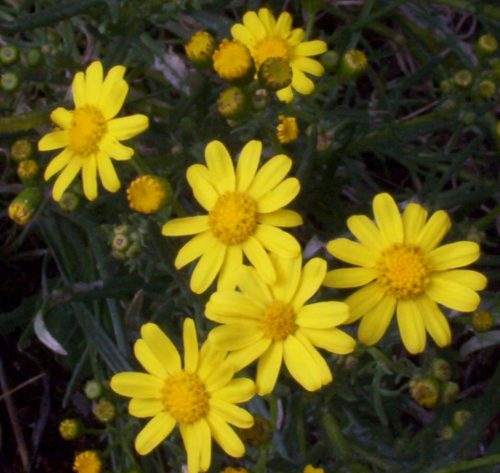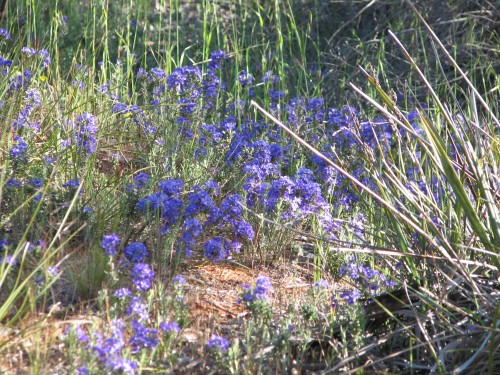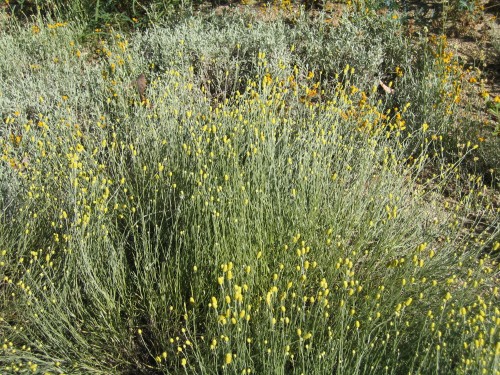Spring flowers: Senecio lautus, a native daisy

Native daisy Senecio lautus flowering in our small piece of scrub.
Why are you growing weeds? I was a bit taken a back because as far as I knew Senecio lautus was an Australian Native daisy. So what is a definition of a weed?
My understanding is that weeds:
- are introduced species from another continent, usually brought in by people knowingly or unknowingly eg. in the padding in saddles in the ‘olden days’.
- are introduced species which have become escapees from garden environments eg. watsonias and Acacia baileyana in the Adelaide Hills
- native species planted for a specific purpose which have escaped that particular environment
- native species which seed all over the place and take over garden beds. Some people don’t mind this but to others it is a nuisance and the plant is therefore a weed.
Senecio lautus may come into the latter category, but I don’t mind at all. Bring it on, I say. They flower among the mallee trees on our block, come up in pots where I don’t want them, flower prolifically along the South Eastern Freeway on the way to Adelaide and give a glorious glow of warmth on cold cloudy days.
They are easily pulled out if not wanted in a specific location. Some appear to be perennial up to 60-70cm tall, others flower at about 30cm, some require cutting back after flowering to maintain a neat bush. Many just appear to die back and re-shoot when it rains in early winter. I consider them worth having, but of course once you have one seed in the garden you are likely to have them next season whether you want them or not! Find out more about Senecio lautus.
I picked some yesterday morning in an experiment to see if they would last as a cut flower. I hadn’t bothered to try before. I will report back. One thing I did notice is that some flowers closed their petals last night.
What’s flowering in May?
There are quite a few plants flowering in my district in May. They include Swainsona formosa, Acacia iteaphylla, Eremophila maculata forms, to name a few. This has stimulated me to begin again on my blog, as well as the queries for information that I periodically receive. My lifestyle has changed and should allow me to pick up again.
Swainsona formosa may seem to be an unlikely plant to include in this list. However a roughly 5square metres front yard of a house in the town has been sown completely to the Sturt’s Desert Pea. The owner described to me that he threw a handful of seed over the yellow gravel he had spread over the area which may have been lawn before. He did it at this time of the year relying on natural rainfall to germinate the seed. He applied some extra water during the height of summer to keep them going. The result was a gorgeous display of red flowers with the black eye, against the grey green foliage. He showed me where more seed was germinating in some of the bare patches. He also had an abundance of seed pods filled with seed, a handful of which he generously gave to me.
Olearia passerinoides
Olearia passerinoides is a mallee daisy and is quite a large bush with bright green leaves, different to many mallee daisies which often have grey green leaves. Although this is a shrub, to me it behaves as a perennial shrub, in that new growth appears along the older wood.
The bush has a tendency to become scruffy, with the leaves higher up the stems and the flowers also high. If it was cut back to the lower growths, it would have dense foliage and be a more compact plant, and I suspect the flowering would also be quite spectacular.
As usual, I promise myself that I will do this, and yet another season goes buy. Mine have just finished flowering, so out with the secateurs tomorrow, while I think of it.
Olearia passerinoides is drought, lime and frost tolerant. It has clusters of small white daisies and grows to 2-3m tall by about 1.5-2m wide if left to its own devices. Pruning will keep it to a more compact size.
Dampiera rosmarinifolia
Calocephalus citreus (Lemon Beauty-heads)
Calocephalus citreus is a small member of the daisy family, growing 20-50 cm high by 30-60 cm wide. It has silver grey foliage and small, yellow button type flowerheads in late Spring to Summer. The photo was taken in early January at Canberra Botanic Gardens.
This plant is perennial and should be pruned after flowering when new growths begin near the base of the plant. It is hardy in most situations and withstands dry periods.
I would call it a drought tolerant plant when I observe its survival here. It grows in loam and sand, in half to full sun, including dappled sun.
This attractive daisy dries well for use in flower arrangements.



